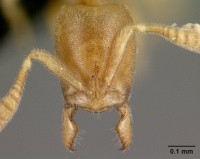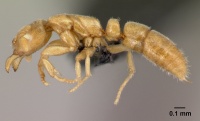Hypoponera perparva
| Hypoponera perparva | |
|---|---|

| |
| Scientific classification | |
| Kingdom: | Animalia |
| Phylum: | Arthropoda |
| Class: | Insecta |
| Order: | Hymenoptera |
| Family: | Formicidae |
| Subfamily: | Ponerinae |
| Tribe: | Ponerini |
| Genus: | Hypoponera |
| Species: | H. perparva |
| Binomial name | |
| Hypoponera perparva Bolton & Fisher, 2011 | |
Known only from a few collections made from rainforest leaf-litter and a single collection from grassland.
Identification
Hypoponera perparva is a minute species that closely resembles Hypoponera angustata, but there are very obviously only four enlarged apical funicular segments in that species, whereas in perparva there are vaguely five. In this respect Hypoponera perparva falls between angustata and the remainder of the Afrotropical fauna, where there are usually definitely five enlarging segments but sometimes vaguely six. H. perparva is also characterised by its small size, short scapes and relatively long petiole.
A member of the abeillei group.
Keys including this Species
Distribution
Known from Congo, South Africa and Tanzania.
Latitudinal Distribution Pattern
Latitudinal Range: -0.76902° to -31.22888889°.
| North Temperate |
North Subtropical |
Tropical | South Subtropical |
South Temperate |
- Source: AntMaps
Distribution based on Regional Taxon Lists
Afrotropical Region: Congo, South Africa (type locality), United Republic of Tanzania.
Distribution based on AntMaps
Distribution based on AntWeb specimens
Check data from AntWeb
Countries Occupied
| Number of countries occupied by this species based on AntWiki Regional Taxon Lists. In general, fewer countries occupied indicates a narrower range, while more countries indicates a more widespread species. |

|
Estimated Abundance
| Relative abundance based on number of AntMaps records per species (this species within the purple bar). Fewer records (to the left) indicates a less abundant/encountered species while more records (to the right) indicates more abundant/encountered species. |

|
Biology
Castes
Nomenclature
The following information is derived from Barry Bolton's Online Catalogue of the Ants of the World.
- perparva. Hypoponera perparva Bolton & Fisher, 2011: 82, figs. 91-93 (w.) SOUTH AFRICA.
Unless otherwise noted the text for the remainder of this section is reported from the publication that includes the original description.
A short series of minute workers from Congo (MSNM and MZUF) is tentatively assigned to perparva here. These specimens match the holotype in all respects except for some variation in measurements. The Congo workers have HL 0.40–0.41, HW 0.30–0.31, HS 0.350–0.360, SL 0.24, PrW 0.21–0.22, WL 0.48–0.50, HFL 0.23–0.24, PeNL 0.12–0.13, PeH 0.20–0.21, PeNW 0.14, PeS 0.155–0.160, CI 74–76, SI 77–80, PeNI 64–67, LPeI 60–62, DPeI 108–117 and SL/HL 0.58–0.60. With only a short series available it is impossible to determine the significance of the slightly smaller overall size but slightly longer scape exhibited by the Congo specimens. For the present they are treated as a single species, until the time when more material becomes available for examination.
Description
Worker
(holotype in parentheses). Measurements: HL 0.40–0.44 (0.42), HW 0.30–0.33 (0.33), HS 0.350–0.385 (0.375), SL 0.24–0.26 (0.24), PrW 0.21–0.25 (0.23), WL 0.48–0.54 (0.54), HFL 0.23–0.25 (0.25), PeNL 0.12–0.13 (0.13), PeH 0.20–0.24 (0.23), PeNW 0.14–0.16 (0.14), PeS 0.155–0.173 (0.167) (10 measured). Indices: CI 73–79 (79), SI 73–81 (73), PeNI 61–67 (61), LPeI 52–62 (57), DPeI 108–120 (108).
Eyes absent. Scape very short; when laid straight back from its insertion the apex falls far short of the midpoint of the posterior margin in full-face view (distance ca 0.38 × SL); SL/HL 0.57–0.60. Funiculus of antenna only vaguely with five enlarging segments apically; the four apical funicular segments (8–11) enlarged; segment 8 somewhat larger than 7 but distinctly smaller than 9. Cephalic dorsum minutely reticulate-punctate. Mesonotal-mesopleural suture absent. Dorsum of mesosoma without trace of a metanotal groove. Propodeal declivity narrow; declivity rounds into the sides through a blunt angle, without a carina or sharp angle separating them. Pronotal dor-sum with very weak, superficial, punctulate sculpture, much weaker and less dense than on the head. Petiole node in dorsal view only very slightly broader than long (DPeI 120 or less). In profile anterior and posterior faces of node convergent dorsally; length of dorsum usually about 0.75 × the length at the level of the anterior tubercle. Subpetiolar process with a low, blunt, obtuse angle in the ventral margin. In dorsal view the maximum width of the first tergite is less than the width of the second tergite at its midlength. Base of cinctus of second gastral tergite with a row of short, longitudinal cross-ribs. Sides of second gastral tergite shallowly convex in dorsal view; midline length of second gastral posttergite, from posterior margin of cinctus to apex, is less than the maximum width of the segment. Disc of second gastral tergite microreticulate. Dorsal surface of first gastral tergite with short pubescence and with a few very short, projecting setae. Full adult colour yellow.
Type Material
Holotype worker, South Africa: Kwazulu Natal, Umtamvuna Nature Reserve, 31°02.704’S, 30°10.080’E, 220 m., 15.xi.2000, Winkler bag extraction leaf litter, KW00-W25, Pondoland Coastal Plateau, sour grassland, CASENT 0395326 (S. van Noort) (California Academy of Sciences).
References
References based on Global Ant Biodiversity Informatics
- Bolton B. and B. L. Fisher. 2011. Taxonomy of Afrotropical and West Palaearctic ants of the ponerine genus Hypoponera Santschi (Hymenoptera: Formicidae). Zootaxa 2843: 1-118
- Bolton, B., and B. L. Fisher. "Taxonomy of Afrotropical and West Palaearctic ants of the ponerine genus Hypoponera Santschi (Hymenoptera: Formicidae)." Zootaxa 2843 (2012): 1-118.


